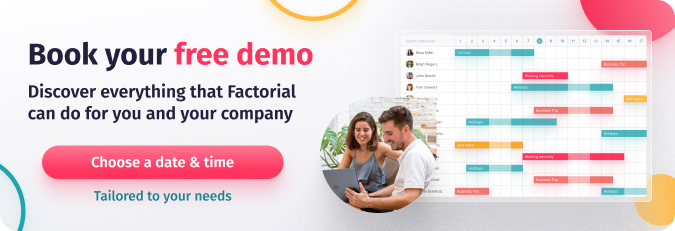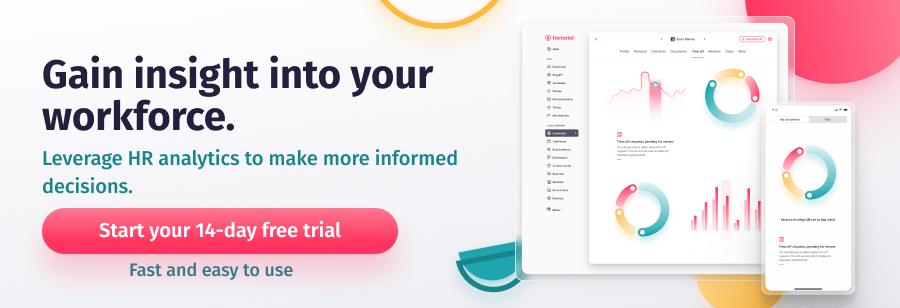In a nutshell, Employee Resource Groups are voluntary, employee-led communities within an organization.
The goal of an ERG is providing a place for the team to connect, support one another, and tackle common challenges. Diversity, belonging, and inclusion are vital components of these groups.
Let’s dive into what an Employee Resource Group is ALL about.
- What Does an Employee Resource Group (ERG) Do?
- Examples of Employee Resource Groups
- The Job Description of an ERG
- Benefits of Employee Resource Groups & Best Practices
- How to Start Your Own ERG using Factorial
What Does an Employee Resource Group Do?
ERGs bring together teams with shared backgrounds, and offer a safe space for teams to share experiences, seek mentorship, and build networks.
ERGs also serve as advocates for their respective communities, raising awareness of issues, and driving positive change within the organization.
The key functions and activities of ERGs can vary depending on the group’s focus and goals. Some common functions of ERGs include:
- Networking and Support. ERGs facilitate connections among teams, creating opportunities for networking, mentorship, and professional development.
- Education and Awareness. ERGs promote cultural understanding and awareness by organizing events, workshops, and educational sessions. These initiatives help educate employees about different cultures, traditions, and perspectives, fostering a more inclusive and respectful work environment.
- Advocacy and Representation. ERGs advocate for underrepresented groups within the organization. ERGs work collaboratively with leadership to ensure fair representation and equal opportunities for all team members.
- Community Outreach. ERGs often engage in community outreach initiatives, partnering with external organizations, and participating in volunteer activities.
Examples of Employee Resource Groups
Employee Resource Groups (ERGs) are everywhere and cover a wide variety of topics. A few examples of industry-specific ERGs:
- Tech Diversity. ERGs that promote diversity and inclusion in tech, focusing on underrepresented groups like women, LGBTQ, and minorities.
- Women’s Leadership. ERGs that advocate for gender equality in leadership, empower women in the workplace, and support their professional growth.
- Veterans Support. ERGs that help veterans transition into civilian careers by connecting them with other veterans and providing resources.
- Disability Inclusion. ERGs that advocate for people with disabilities, raise awareness of accessibility issues, and drive inclusive initiatives.
- Cultural Heritage. Employee resource groups that celebrate the diversity of cultures and traditions.
Our top 5 real examples of Employee Resource Groups are:
- Avison Young, a Canadian commercial real estate company, is working on increasing women’s leadership roles. In order to give women support and opportunities for growth, they created a women’s resource group.
- It’s no secret Ernst & Young (EY) is one of the biggest consulting firms in the world. It has set up many diversity and inclusion ERGs.
- Microsoft’s Women@Microsoft Scholarship (W@M) gives high school girls and non-binary people tech opportunities. A lot of the initiative is for students who want to go to college and get a degree in Science, Technology, Engineering, Arts, and Math.
- Young Professionals at TIAA (YoPros) As part of its DEI initiatives, TIAA launched YoPros, an employee resource group. YoPros provides networking opportunities and career development opportunities for new hires and managers in their early stages.
- The Military Support and Assistance Group at Bank of America assists veterans and active-duty service members. It provides resources and support to military and veteran organizations across the country.
The Job Description of an ERG
An Employee Resource Group (ERG) relies on the active participation and dedication of its members.
The responsibilities and expectations typically include:
- Active Engagement. ERG members are expected to actively participate in group activities, attend meetings, and contribute to the overall mission and goals of the ERG.
- Event Planning and Execution. ERG members plan and execute events, workshops, and initiatives that promote diversity, foster inclusion, and educate.
- Networking and Mentorship. Members network with other teams across the organization, and mentor and support each other.
Would you like to lead ERGs?
Leadership within ERGs is often structured to ensure effective management and representation.
On top, you will find executive sponsors, typically senior leaders within the organization. These leaders provide guidance, support, and resources for the ERG.
Then, you find the committee members, elected or appointed within the ERG. They take on specific roles and responsibilities such as event coordination, communication, or advocacy.
In addition to promoting diversity and fostering an inclusive culture, they help organizations do business & strategies. This is how:
- Supporting Organizational Objectives. ERGs attract and retain diverse talent, enhance team engagement, and drive innovation.
- Improving Team Engagement and Satisfaction. ERGs provide opportunities for networking, professional development, and community building. This, in turn, leads to higher job satisfaction and retention rates.
- Influencing Diversity Values. ERGs play a crucial role in advocacy, fostering awareness, and influencing policies and practices.
Benefits of Employee Resource Groups & Best Practices
We’ve seen a lot of benefits for ERGs so far, but there’s more to them. Here are the main ones:
- Attracting and Retaining Diverse Talent. ERGs contribute to higher employee retention rates, as employees feel a stronger sense of connection and support within the organization.
- Employee Development and Leadership Opportunities. ERGs provide career growth and strengthen the organization’s talent pipeline.
- Innovation and Collaboration. ERGs encourage collaboration across diverse teams, bringing together employees with different backgrounds and perspectives. Which results in synergies in creativity, problem-solving, and idea exchange.
Are you considering joining or creating one of these ERGs in your company? Way to go! Here are some best practices to help you succeed in your own Resource Group:
- Clearly Define Goals and Objectives. Clearly articulate the ERG’s purpose, goals, and expected outcomes. Align these goals with the organization’s diversity and inclusion strategy to ensure synergy and support.
- Encourage Inclusion and Diversity. Make sure ERGs welcome, value, and respect employees from all backgrounds and experiences.
- Promote Active Participation. Offer ERG members opportunities for involvement, like organizing events, leading initiatives, and joining cross-functional teams.
- Establish Effective Communication Channels. Such as regular meetings, email updates, or dedicated online platforms. Encourage open dialogue, feedback, and information sharing among members.
- Engage Leadership Support. Seek support from organizational leaders who can act as sponsors, provide guidance, and allocate the necessary resources to help ERGs thrive.
EXTRA TIPS
- Ensure that ERGs have access to the necessary resources, such as budgetary support, meeting spaces, technology tools, and training opportunities.
- Collaborate with Human Resources and diversity teams to align ERG initiatives with broader organizational strategies, policies, and programs.
How to Start Your Own ERG using Factorial
Our mission is to help your team succeed.
We offer you a HR software solution for managing various aspects of HR operations.
Let’s see how some of our tools will allow you to manage your ERGs effectively:
One of Factorial’s standout features is our HR Reports and Analytics. This feature enables your organization to generate custom reports, visualize data, and leverage analytics to gain valuable insights into your workforce and business performance. Click here to try the tool for free for 14 days!
These are the 3 ways Factorial’s HR Reports and Analytics feature will help you optimize your Employee Resource Group (ERG):
- Generating Custom Reports. Factorial will allow you to create custom reports using data from your Factorial account. ERG leaders can generate reports that provide insights into ERG participation, engagement, and impact of ERG initiatives.
- Visualizing Data. Factorial offers different visualization formats, including predefined reports, galleries, and customizable dashboards. ERG leaders can leverage these visualizations to present data in a clear and visually appealing manner.
- Utilizing Analytics for Decision-Making. By utilizing analytics capabilities within Factorial’s HR Reports and Analytics feature, ERG leaders can gain deeper insights into ERG dynamics and identify patterns or trends.
The other tool which might be very useful for your ERG creation is our Internal Communications & Events feature, which enables seamless collaboration, event planning, and community building.
These are the 4 ways our Internal Communications & Events feature will help you optimize your Employee Resource Group (ERG):
- Creating events and communicating plans. In Factorial’s Internal Communication tool, you can easily create and share events with your team. To ensure clarity and engagement, you can provide details such as date, time, title, description, and images.
- Choosing the recipient and tailoring the communication. You can use the Internal Communication tool to create posts tailored to individuals, the company, or particular groups for effective ERG management.
- Fostering conversations and collaboration. With Factorial’s Internal Communication tool, employees can participate in conversations by adding comments and reactions. Your ERGs will be more engaged and stronger as a result of this interactive feature.
- Creating weekly summaries. ERG success depends on keeping employees informed about company happenings. You can highlight important events, team updates, birthdays, upcoming absences, and remind yourself of tasks and deadlines with Factorial’s Internal Communication tool. Keeping everyone informed and aligned is key.
If you are interested in trying these features for free, just click here and you will get 14 days to see everything.




